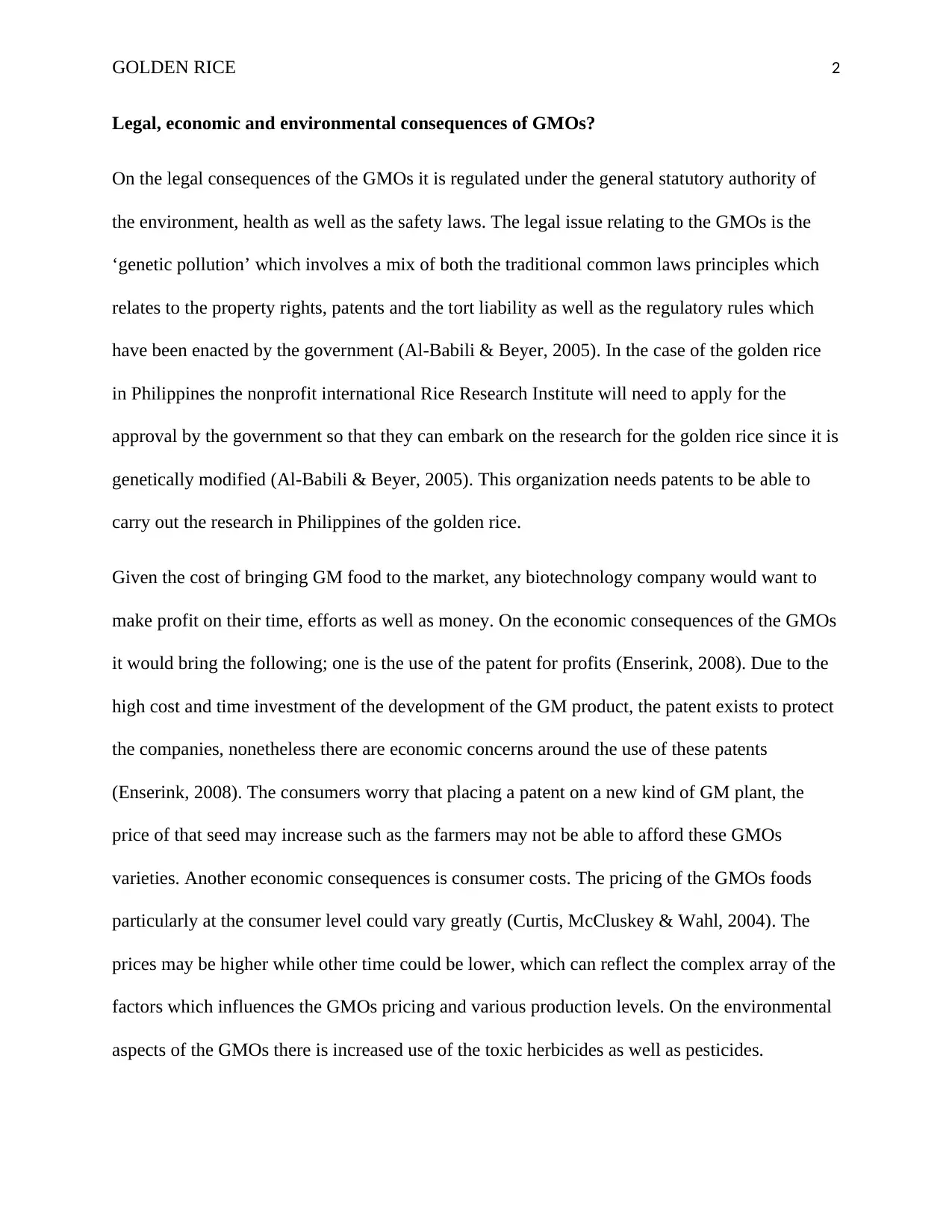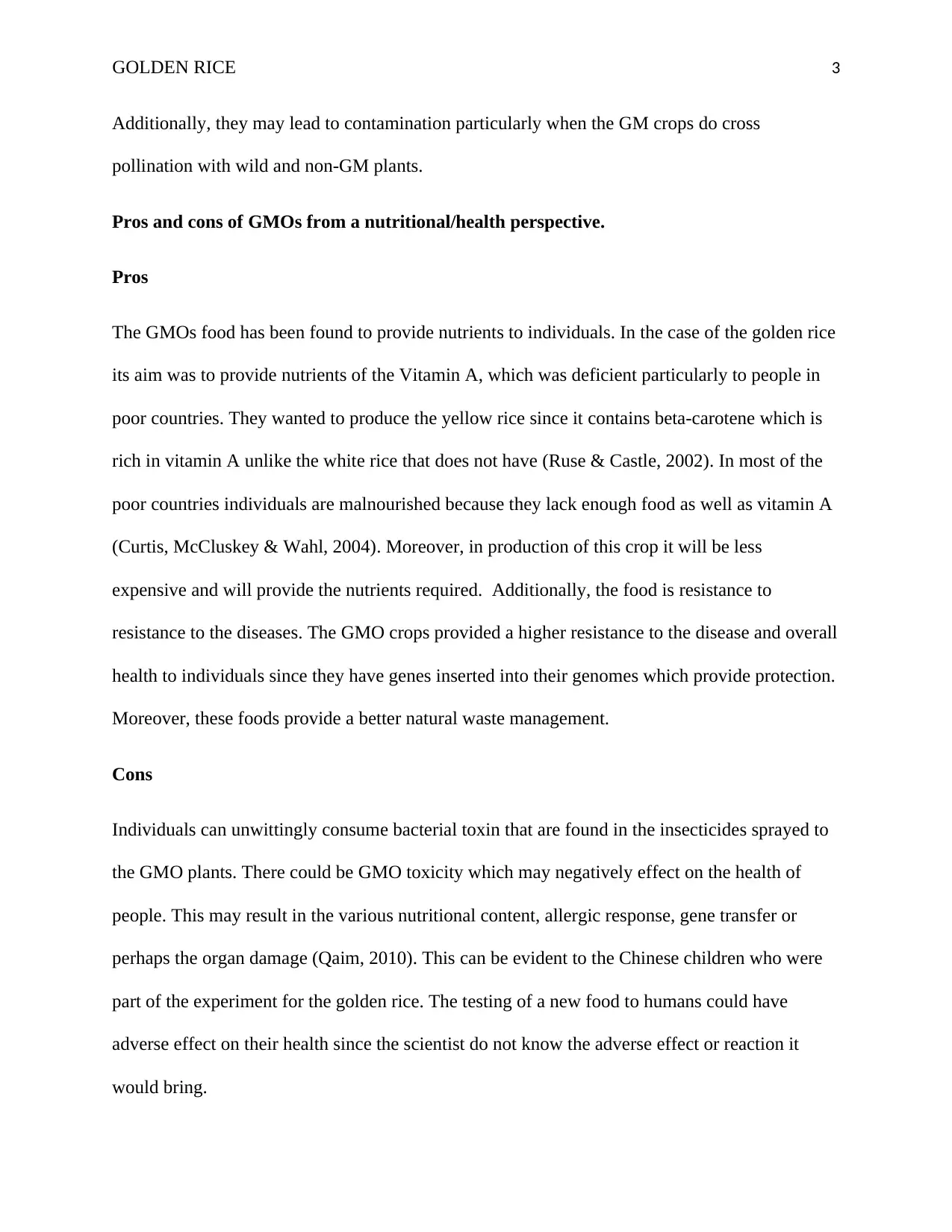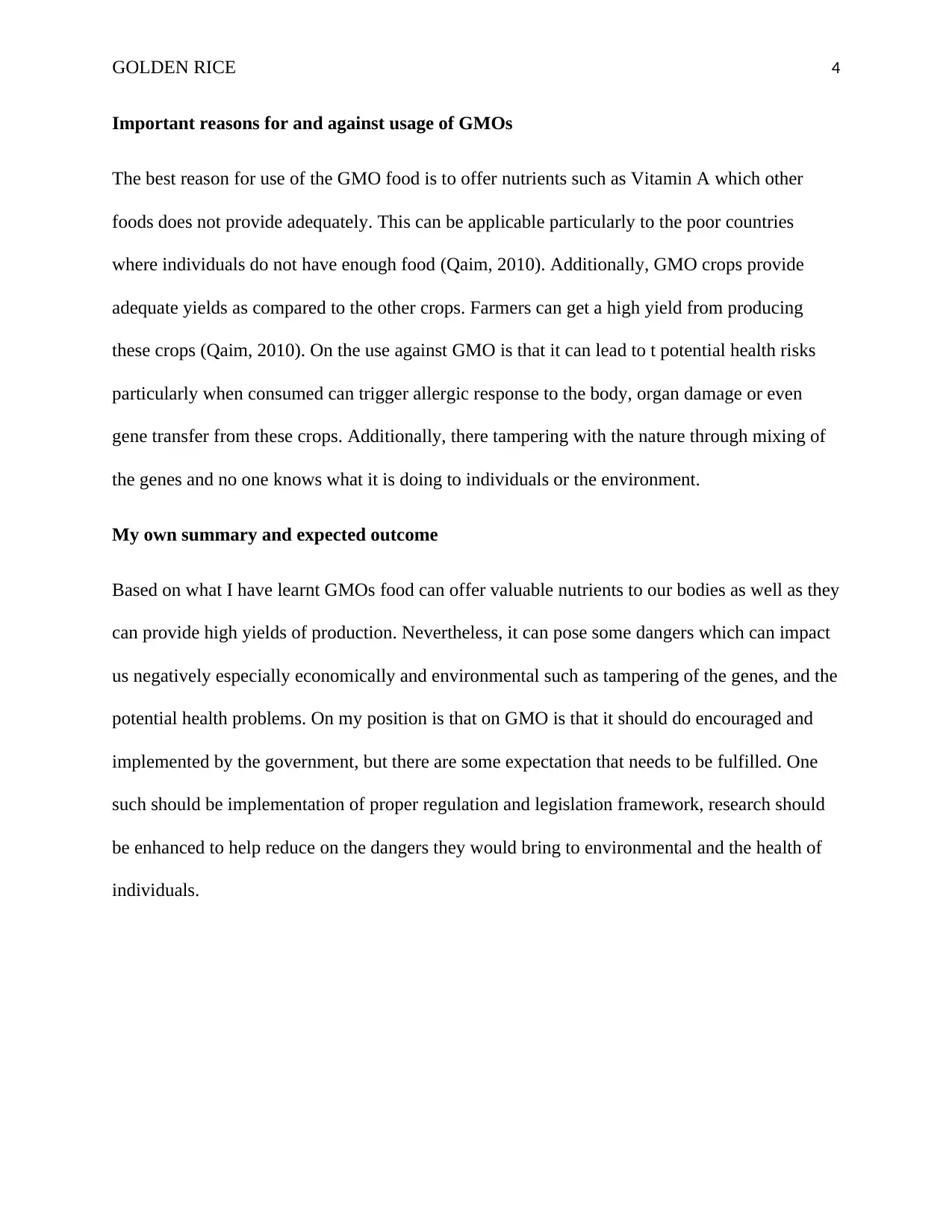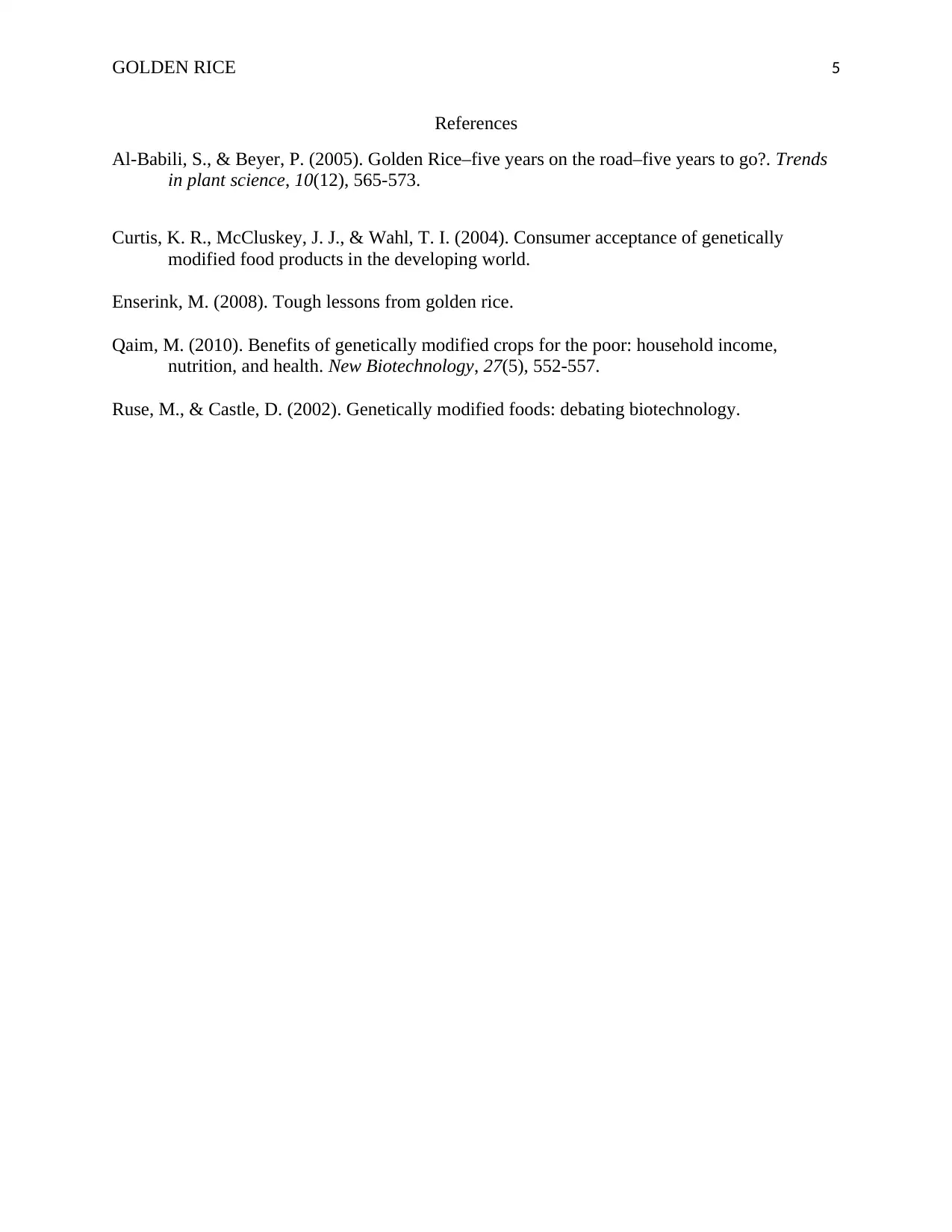Golden Rice and GMOs
VerifiedAdded on 2020/03/13
|5
|1109
|111
Essay
AI Summary
This essay discusses the legal, economic, and environmental consequences of genetically modified organisms (GMOs), focusing on Golden Rice. It examines the benefits of GMOs in providing essential nutrients, particularly Vitamin A, to malnourished populations, while also addressing potential health risks and environmental concerns. The essay concludes with a personal perspective on the need for regulation and research to mitigate the dangers associated with GMOs.

Running head: GOLDEN RICE 1
Golden Rice
Name
Institution Affiliation:
Golden Rice
Name
Institution Affiliation:
Paraphrase This Document
Need a fresh take? Get an instant paraphrase of this document with our AI Paraphraser

GOLDEN RICE 2
Legal, economic and environmental consequences of GMOs?
On the legal consequences of the GMOs it is regulated under the general statutory authority of
the environment, health as well as the safety laws. The legal issue relating to the GMOs is the
‘genetic pollution’ which involves a mix of both the traditional common laws principles which
relates to the property rights, patents and the tort liability as well as the regulatory rules which
have been enacted by the government (Al-Babili & Beyer, 2005). In the case of the golden rice
in Philippines the nonprofit international Rice Research Institute will need to apply for the
approval by the government so that they can embark on the research for the golden rice since it is
genetically modified (Al-Babili & Beyer, 2005). This organization needs patents to be able to
carry out the research in Philippines of the golden rice.
Given the cost of bringing GM food to the market, any biotechnology company would want to
make profit on their time, efforts as well as money. On the economic consequences of the GMOs
it would bring the following; one is the use of the patent for profits (Enserink, 2008). Due to the
high cost and time investment of the development of the GM product, the patent exists to protect
the companies, nonetheless there are economic concerns around the use of these patents
(Enserink, 2008). The consumers worry that placing a patent on a new kind of GM plant, the
price of that seed may increase such as the farmers may not be able to afford these GMOs
varieties. Another economic consequences is consumer costs. The pricing of the GMOs foods
particularly at the consumer level could vary greatly (Curtis, McCluskey & Wahl, 2004). The
prices may be higher while other time could be lower, which can reflect the complex array of the
factors which influences the GMOs pricing and various production levels. On the environmental
aspects of the GMOs there is increased use of the toxic herbicides as well as pesticides.
Legal, economic and environmental consequences of GMOs?
On the legal consequences of the GMOs it is regulated under the general statutory authority of
the environment, health as well as the safety laws. The legal issue relating to the GMOs is the
‘genetic pollution’ which involves a mix of both the traditional common laws principles which
relates to the property rights, patents and the tort liability as well as the regulatory rules which
have been enacted by the government (Al-Babili & Beyer, 2005). In the case of the golden rice
in Philippines the nonprofit international Rice Research Institute will need to apply for the
approval by the government so that they can embark on the research for the golden rice since it is
genetically modified (Al-Babili & Beyer, 2005). This organization needs patents to be able to
carry out the research in Philippines of the golden rice.
Given the cost of bringing GM food to the market, any biotechnology company would want to
make profit on their time, efforts as well as money. On the economic consequences of the GMOs
it would bring the following; one is the use of the patent for profits (Enserink, 2008). Due to the
high cost and time investment of the development of the GM product, the patent exists to protect
the companies, nonetheless there are economic concerns around the use of these patents
(Enserink, 2008). The consumers worry that placing a patent on a new kind of GM plant, the
price of that seed may increase such as the farmers may not be able to afford these GMOs
varieties. Another economic consequences is consumer costs. The pricing of the GMOs foods
particularly at the consumer level could vary greatly (Curtis, McCluskey & Wahl, 2004). The
prices may be higher while other time could be lower, which can reflect the complex array of the
factors which influences the GMOs pricing and various production levels. On the environmental
aspects of the GMOs there is increased use of the toxic herbicides as well as pesticides.

GOLDEN RICE 3
Additionally, they may lead to contamination particularly when the GM crops do cross
pollination with wild and non-GM plants.
Pros and cons of GMOs from a nutritional/health perspective.
Pros
The GMOs food has been found to provide nutrients to individuals. In the case of the golden rice
its aim was to provide nutrients of the Vitamin A, which was deficient particularly to people in
poor countries. They wanted to produce the yellow rice since it contains beta-carotene which is
rich in vitamin A unlike the white rice that does not have (Ruse & Castle, 2002). In most of the
poor countries individuals are malnourished because they lack enough food as well as vitamin A
(Curtis, McCluskey & Wahl, 2004). Moreover, in production of this crop it will be less
expensive and will provide the nutrients required. Additionally, the food is resistance to
resistance to the diseases. The GMO crops provided a higher resistance to the disease and overall
health to individuals since they have genes inserted into their genomes which provide protection.
Moreover, these foods provide a better natural waste management.
Cons
Individuals can unwittingly consume bacterial toxin that are found in the insecticides sprayed to
the GMO plants. There could be GMO toxicity which may negatively effect on the health of
people. This may result in the various nutritional content, allergic response, gene transfer or
perhaps the organ damage (Qaim, 2010). This can be evident to the Chinese children who were
part of the experiment for the golden rice. The testing of a new food to humans could have
adverse effect on their health since the scientist do not know the adverse effect or reaction it
would bring.
Additionally, they may lead to contamination particularly when the GM crops do cross
pollination with wild and non-GM plants.
Pros and cons of GMOs from a nutritional/health perspective.
Pros
The GMOs food has been found to provide nutrients to individuals. In the case of the golden rice
its aim was to provide nutrients of the Vitamin A, which was deficient particularly to people in
poor countries. They wanted to produce the yellow rice since it contains beta-carotene which is
rich in vitamin A unlike the white rice that does not have (Ruse & Castle, 2002). In most of the
poor countries individuals are malnourished because they lack enough food as well as vitamin A
(Curtis, McCluskey & Wahl, 2004). Moreover, in production of this crop it will be less
expensive and will provide the nutrients required. Additionally, the food is resistance to
resistance to the diseases. The GMO crops provided a higher resistance to the disease and overall
health to individuals since they have genes inserted into their genomes which provide protection.
Moreover, these foods provide a better natural waste management.
Cons
Individuals can unwittingly consume bacterial toxin that are found in the insecticides sprayed to
the GMO plants. There could be GMO toxicity which may negatively effect on the health of
people. This may result in the various nutritional content, allergic response, gene transfer or
perhaps the organ damage (Qaim, 2010). This can be evident to the Chinese children who were
part of the experiment for the golden rice. The testing of a new food to humans could have
adverse effect on their health since the scientist do not know the adverse effect or reaction it
would bring.
⊘ This is a preview!⊘
Do you want full access?
Subscribe today to unlock all pages.

Trusted by 1+ million students worldwide

GOLDEN RICE 4
Important reasons for and against usage of GMOs
The best reason for use of the GMO food is to offer nutrients such as Vitamin A which other
foods does not provide adequately. This can be applicable particularly to the poor countries
where individuals do not have enough food (Qaim, 2010). Additionally, GMO crops provide
adequate yields as compared to the other crops. Farmers can get a high yield from producing
these crops (Qaim, 2010). On the use against GMO is that it can lead to t potential health risks
particularly when consumed can trigger allergic response to the body, organ damage or even
gene transfer from these crops. Additionally, there tampering with the nature through mixing of
the genes and no one knows what it is doing to individuals or the environment.
My own summary and expected outcome
Based on what I have learnt GMOs food can offer valuable nutrients to our bodies as well as they
can provide high yields of production. Nevertheless, it can pose some dangers which can impact
us negatively especially economically and environmental such as tampering of the genes, and the
potential health problems. On my position is that on GMO is that it should do encouraged and
implemented by the government, but there are some expectation that needs to be fulfilled. One
such should be implementation of proper regulation and legislation framework, research should
be enhanced to help reduce on the dangers they would bring to environmental and the health of
individuals.
Important reasons for and against usage of GMOs
The best reason for use of the GMO food is to offer nutrients such as Vitamin A which other
foods does not provide adequately. This can be applicable particularly to the poor countries
where individuals do not have enough food (Qaim, 2010). Additionally, GMO crops provide
adequate yields as compared to the other crops. Farmers can get a high yield from producing
these crops (Qaim, 2010). On the use against GMO is that it can lead to t potential health risks
particularly when consumed can trigger allergic response to the body, organ damage or even
gene transfer from these crops. Additionally, there tampering with the nature through mixing of
the genes and no one knows what it is doing to individuals or the environment.
My own summary and expected outcome
Based on what I have learnt GMOs food can offer valuable nutrients to our bodies as well as they
can provide high yields of production. Nevertheless, it can pose some dangers which can impact
us negatively especially economically and environmental such as tampering of the genes, and the
potential health problems. On my position is that on GMO is that it should do encouraged and
implemented by the government, but there are some expectation that needs to be fulfilled. One
such should be implementation of proper regulation and legislation framework, research should
be enhanced to help reduce on the dangers they would bring to environmental and the health of
individuals.
Paraphrase This Document
Need a fresh take? Get an instant paraphrase of this document with our AI Paraphraser

GOLDEN RICE 5
References
Al-Babili, S., & Beyer, P. (2005). Golden Rice–five years on the road–five years to go?. Trends
in plant science, 10(12), 565-573.
Curtis, K. R., McCluskey, J. J., & Wahl, T. I. (2004). Consumer acceptance of genetically
modified food products in the developing world.
Enserink, M. (2008). Tough lessons from golden rice.
Qaim, M. (2010). Benefits of genetically modified crops for the poor: household income,
nutrition, and health. New Biotechnology, 27(5), 552-557.
Ruse, M., & Castle, D. (2002). Genetically modified foods: debating biotechnology.
References
Al-Babili, S., & Beyer, P. (2005). Golden Rice–five years on the road–five years to go?. Trends
in plant science, 10(12), 565-573.
Curtis, K. R., McCluskey, J. J., & Wahl, T. I. (2004). Consumer acceptance of genetically
modified food products in the developing world.
Enserink, M. (2008). Tough lessons from golden rice.
Qaim, M. (2010). Benefits of genetically modified crops for the poor: household income,
nutrition, and health. New Biotechnology, 27(5), 552-557.
Ruse, M., & Castle, D. (2002). Genetically modified foods: debating biotechnology.
1 out of 5
Your All-in-One AI-Powered Toolkit for Academic Success.
+13062052269
info@desklib.com
Available 24*7 on WhatsApp / Email
![[object Object]](/_next/static/media/star-bottom.7253800d.svg)
Unlock your academic potential
Copyright © 2020–2025 A2Z Services. All Rights Reserved. Developed and managed by ZUCOL.